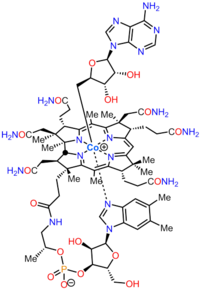
Photo from wikipedia
Abstract A series of novel Si/Ti–based amino–functionalized (i.e. –NH2–) hybrids were synthesized through a sol–gel route. Their adsorption towards cobalt(II) was investigated. Fourier transform infrared spectra confirmed the presence of… Click to show full abstract
Abstract A series of novel Si/Ti–based amino–functionalized (i.e. –NH2–) hybrids were synthesized through a sol–gel route. Their adsorption towards cobalt(II) was investigated. Fourier transform infrared spectra confirmed the presence of functionalized groups in the chains of molecules. Thermogravimetric analyses showed the heat stability of these hybrids beyond 430 °C. Differential scanning calorimetry thermal analyses indicated that adding Ti(OB)4 into the previously-prepared hybrids cannot affect the temperature of melting-point. The adsorption of cobalt(II) on these hybrids obeyed the Lagergren pseudo-second-order kinetic model, diffusion–chemisorption as well as the Langmuir isotherm model. However, the Elovich model displayed that chemisorption was not the key adsorption mode as cobalt(II) was adsorbed. Clearly, such trend proved that the adsorption of cobalt(II) on these hybrids is chiefly organized by diffusion–chemisorption mechanism. Additionally, the field–emission scanning electron microscopy and energy dispersive spectrometer images gave direct evidences to support the presence of cobalt(II) on the surface of adsorbed specimen. These findings disclose that these Si/Ti–based hybrids are favorable separating species for cleaning cobalt(II) from cobalt–containing water.
Journal Title: Journal of Molecular Liquids
Year Published: 2019
Link to full text (if available)
Share on Social Media: Sign Up to like & get
recommendations!